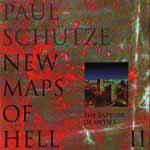new maps of hell II: the rapture of metals
Big Cat 1996
written, performed and produced by Paul Schütze
1. the rapture of concealment
2. rapture of the drowning
3. the rapture of ornament
4. the rapture of metals
5. rapture of the skin
6. sites of rapture on the lungs of god
For all the myriad beauties of the electronic diaspora webbing the world, joining up London, Frankfurt, Berlin, Moscow, Melbourne, Tokyo, Detroit, and on ad infinitum, connecting bush cattleherders to the Chicago meat markets, and isolated hamlets to bursting city micro-states, its Western subscribers for the most part have not yet rid themselves of the somewhat ugly, archaic practice of musical colonization, pillage and plunder.
Today's information technology has made it so easy to lift and loop "interesting" exotic sounds and rhythms that it's obviated the need and, more sadly, the desire of many Western producers to investigate the origins or explore the properties of the materials they use to patchwork purportedly shamanic, but spiritually threadbare dance tracks. The upshot is, much contemporary electronic music is like flying around the world and never venturing beyond the airport shopping zones, it's that thrilling. Its gurus make grand claims on behalf of the music's ability to transport the listener into other psychic states, but in truth few of them have come close to fully developing a psychology for its Heart of Darkness journeying. Maybe it was his very geographical proximity (before he moved to London) to those musical zones often name-checked or plundered " Papua New Guinea, Bali, Java " that inoculated the Australian Paul Schütze against the infectiously simple practice of grafting "exotica" on to music with a view to making a quick return on it. But anyway the time he spent studying percussion had given him a totally different handle on these musics: their tonal properties, their meanings, and their ritual uses. And besides, he's not the type to take these things lightly. I mean, stealing fetishes is all very well until the voodoo hunts you down and demands repayment in full.
Schütze once stated that the most valid form of criticism isn't that which can be articulated in words, but that which comes from within and displaces the thing it is critiquing. So what does The Rapture of Metals do that other non-vocal instrumental electronic musics rollered on gamelan-styled percussion rhythms don't? Well, for one, it is the product of a fully developed psychology of a heart of darkness journey ; most specifically the journey into the dark heat charted on New Maps of Hell. Conceived as a companion disc to that release, The Rapture of Metals at once takes off where New Maps concludes (now with its original ending restored to bring that disc to a more combustible finale) and acts as an X-ray snapshot of its disintegrating soul.
The pinpoint accuracy of electronic keyboards, with which Schütze mints the sounds that alert you to the psychic states this music's mapping, make them the ideal means for exploring a collapsing nervous system, the body's infrastructure, so to speak, brought to a similar catastrophic state as the infrastructure of the city traversed by the New Maps narrative. But even more impressive is how Schütze propels listeners inward and keeps them moving through his interiors by means of his gamelan-like rhythm tracks, which parallel his exploration of their at times cavernous tones to the music's introspective leanings. And because he plays them in real time, rather than simply looping and repeating them, the music defies the concrete certainties that sink so much computer-generated ambient or dance stuff, to which Schütze thankfully swears no allegiance.
Indeed, its sand shift rhythms keep the music in a constant state of flux. The way it evolves, it's almost impossible to hear it the same way twice. You always seem to be entering or leaving at different points. Schütze interleaves the percussion weave, keyboards, atmospheres and melodies with such finesse you follow the music, each time on a different strand and hear the whole from its perspective.
Paradoxically, if New Maps of Hell logs the soul's disintegration with appalled fascination, the view from the interior provided by Rapture is that of an individual who has moved beyond fear and despair to acceptance and even wonder at his own predicament. By the time it reaches the final track, the wonderfully titled "Sites of Rapture on the Lungs of God", the music has achieved the level of stillness of near-death, and its raptures are the little ruptures that serve to emphasise its closeness to silence. Bliss.
Biba Kopf, The Hidden Reverse, 1995
digital editing: Frazer Henry
digital mastering: Denis Blackham At Porky's
cover design: Anne-Louise Falson + Paul Schütze
